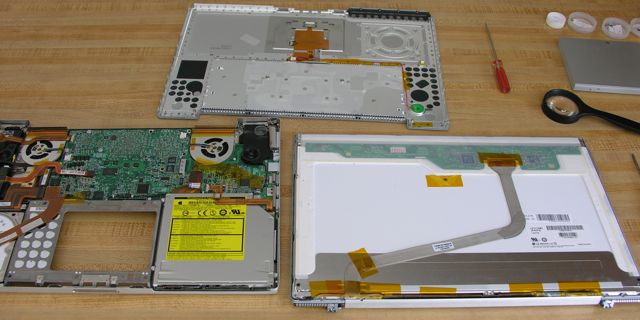
Click on the image above to see an enlargement of the PowerBook dissected, in a new window.
Knowing that I owned a PowerBook, an associate came to me with a 17" PowerBook whose video was awry: the video was striated, broken up, with partial color. Could anything be done with it?
I hadn't experienced such a problem with my own PowerBook, so I performed a Web search. As is common with Web searches, you find a lot of dead ends and misinformation. There were quite a few pleas for advice on such a problem, but few substantive answers. A lot of responses talked of problems with "the inverter", many of them parroting others having cited "the inverter" as the problem. This is the kind of misdirection found on the Web from people who just don't understand the underlying technologies.
Laptop displays are based upon liquid crystal panels, where a million or more tiny cells each contain a liquid crystal element which will flip like a window shutter when a tiny current is applied, resulting in a lighter/darker effect, and thence an image element. The whole constitutes a Liquid Crystal Display (LCD). For this shuttering to result in a readily visible light/dark spot, there has to be some lighting source. In the early days of liquid crystal, as found in calculators, for example, the background behind the LC matrix would be mirrored, depending upon ambient light to provide the means whereby lightness vs. darkness contrast could be perceived: this was reflective LCD technology. This was okay up to a point, but inconsistent, and as such unsuitable for laptop displays. For good imagery, backlighting was called for, where the shuttering would either allow light to pass or be blocked. But what kind of light source would be thin enough for a laptop lid? A good, bright source is fluorescence, as in a tubular ceiling bulb, but thin and flat. That works, but: exciting the internal gas to fluourescence requires alternating current and, obviously, laptops carry direct current batteries. Well, then, some form of conversion from DC to AC is required. That is performed by what is called an inverter, being a special circuit to convert the power and usually boost its voltage. There is typically such a (flat) circuit assembly inside the laptop lid, along with the LCD panel. This provides a uniform backlighting over the full dimensions of the display. As such, it's not going to result in color striations or similar irregular image problems. (Very recently, both laptops and televisions are transitioning away from fluorescent backlighting to semiconductor, LED backlighting.) End of inverter tutorial, and our interest in the inverter as possible problem cause.
So, what could be the problem with this PowerBook? The answer became clear through minor experimentation: open or close the lid a bit with the display on, and the irregularities would become - well - more irregular. This pointed to a cable problem.
A tremendous weak link in a laptop is the path to the display. The imagery is generated in circuitry contained within the body of the laptop, and has to get to the display, which is in the lid. The only connection between the two "halves" is a narrow hinge. And, believe it or not, both a video cable and inverter power cable have to somehow go from the laptop body into the hinge, and then into the lid. That involves considerable contortion. That means bending of the cables. And, as most of us know, wires are metal, and metal doesn't like to be repeatedly flexed: eventually, repeated bending results in failure of the crystal bonds in the metal, and you get what is called "fatigue failure". Where a wire breaks, and then flexing causes its separated ends to intermittently make contact, you get intermittent current. In a video cable, this results in broken up and jittery imagery.
This was my diagnosis of the PowerBook's problem. If it could be fixed, it would mean both considerable disassembly and finding a replacement cable somewhere — one that was in good condition, removed from old equipment (given that no new parts would be available).
As the pictures which follow testify, I did undertake disassembly, and did indeed succeed in fixing the video problem on this PowerBook; and I successfully reassembled the whole thing, with no little parts unaccountably left over. However, I will advise anyone contemplating doing the same that:
I won't dwell on the disassembly and fixing steps. The videos and pictures below will outline the more detailed elements of the work. Some things of note:

Click on the image above to see an enlargement of the PowerBook dissected, in a new window.
The picture below shows a close-up of the failure point on the removed video cable. The arrow points at the failure area. Just to the right of the arrow you can see a convex, cupped, flat area, which is where the cable wrapped around the hinge. From there it had to change into a narrow cable of round cross-section, to fit inside the hinge. The transition area was subject to much flexing as the hinge was opened and closed with the lid of the laptop, and eventually caused the wires inside that very stressed torsion area to finally break. The yellowish part of the cable to the left ran to the connector on the body of the PowerBook.

Click on the image above to see an enlargement of the video cable failure point, in a new window.
The great, big moral of this whole story is to avoid frequently opening and closing any laptop lid, and in particular to not do so quickly (which generates destructive heat amongst the metal's crystals). Further, this points out a tremendous advantage of the iPad: no lid, no conspicuously point of failure.